1.1 flask介绍
参考博客: https://www.cnblogs.com/sss4/p/8097653.html
1、django、tornado、flask比较
1. Django:1个重武器,包含了web开发中常用的功能、组件的框架;(ORM、Session、Form、Admin、分页、中间件、信号、缓存、ContenType....);
2. Tornado:2大特性就是异步非阻塞、原生支持WebSocket协议;
3. Flask:封装功能不及Django完善,性能不及Tornado,但是Flask的第三方开源组件比丰富;http://flask.pocoo.org/extensions/
2、使用参考
1. 小型web应用设计的功能点不多使用Flask;
2. 大型web应用设计的功能点比较多使用的组件也会比较多,使用Django(自带功能多不用去找插件);
3. 如果追求性能可以考虑Tornado;
3、flask介绍
1. Flask是一个基于Python开发并且依赖jinja2模板和Werkzeug WSGI服务的一个微型框架
2. 对于Werkzeug本质是Socket服务端,其用于接收http请求并对请求进行预处理,然后触发Flask框架
3. 开发人员基于Flask框架提供的功能对请求进行相应的处理,并返回给用户
4. 如果要返回给用户复杂的内容时,需要借助jinja2模板来实现对模板的处理
5. 即:将模板和数据进行渲染,将渲染后的字符串返回给用户浏览器。
6. 如同是 Flask 本身实现的一样。众多的扩展提供了数据库集成、表单验证、上传处理、各种各样的开放认证技术等功能
4、安装
pip install flask
1.2 flask简单使用
1、定义路由
@app.route('/')是装饰器,定义如下:
app.route(rule, options)
rule参数:是绑定URL与函数。
options参数:是可选参数。
2、run() 函数来让应用运行在本地服务器上。定义如下 :
app.run(host, port, debug, options)
host:服务器主机名,默认是127.0.0.1 (localhost),如果设置0.0.0.0可以在本机之外访问。
port:主机端口,默认是5000。
debug:调试模式,默认是false;如果设置true,服务器会在代码修改后自动重新载入。
options:可选参数。

from flask import Flask app = Flask(__name__) @app.route('/') def hello_world(): return 'Hello World' if __name__ == '__main__': app.run(debug=True)
1.3 路由系统
1、动态路由获取参数
1. request.form # 获取post请求
2. request.values.get('name') 或 request.args.get('name') # 获取post请求数据
3. 访问:http://127.0.0.1:5000/user/zhangsan?name=aaa

#! /usr/bin/env python # -*- coding: utf-8 -*- from flask import Flask from flask import request app=Flask(__name__) @app.route('/user/<name>') #设置url传参数 http://127.0.0.1:5000/user/zhangsan?name=aaa def first_flask(name): #视图必须有对应接收参数 print(name) # zhangsan print(request.form) # 获取post请求 print(request.values.get('name')) # 获取get请求中参数 print(request.args.get('name')) # 获取get请求中参数 return 'Hello World' if __name__ == '__main__': app.run()
2、指定允许的请求方法( @app.route('/login', methods=['GET', 'POST']) )
1. @app.route('/login', methods=['GET', 'POST']) # 指定允许的请求

#! /usr/bin/env python # -*- coding: utf-8 -*- from flask import Flask from flask import request app=Flask(__name__) @app.route('/<path:url>/',methods=['get']) #只允许get请求 def first_flask(url): print(url) # http://www.baidu.com return 'Hello World' #response if __name__ == '__main__': app.run()
3、反向生成url

#! /usr/bin/env python # -*- coding: utf-8 -*- from flask import Flask,url_for from flask import request #反向生成url app=Flask(__name__) @app.route('/<path:url>',endpoint='name1') def first_flask(url): print(url_for('name1',url=url)) #如果设置了url参数,url_for(别名,加参数) return 'Hello World' if __name__ == '__main__': app.run()
4、通过app.add_url_rule()调用路由
http://127.0.0.1:5000/index/

#! /usr/bin/env python # -*- coding: utf-8 -*- from flask import Flask,url_for from flask import request #方式2通过app.add_url_rule()方法的方式调用路由 app=Flask(__name__) def first_flask(): return 'Hello World' app.add_url_rule(rule='/index/',endpoint='name1',view_func=first_flask,methods=['GET']) #app.add_url_rule(rule=访问的url,endpoint=路由别名,view_func=视图名称,methods=[允许访问的方法]) if __name__ == '__main__': app.run()
5、扩展路由功能:正则匹配url

from flask import Flask, views, url_for from werkzeug.routing import BaseConverter app = Flask(import_name=__name__) class RegexConverter(BaseConverter): """ 自定义URL匹配正则表达式 """ def __init__(self, map, regex): super(RegexConverter, self).__init__(map) self.regex = regex def to_python(self, value): """ 路由匹配时,匹配成功后传递给视图函数中参数的值 :param value: :return: """ return int(value) def to_url(self, value): """ 使用url_for反向生成URL时,传递的参数经过该方法处理,返回的值用于生成URL中的参数 :param value: :return: """ val = super(RegexConverter, self).to_url(value) return val # 添加到flask中 app.url_map.converters['regex'] = RegexConverter # http://127.0.0.1:5000/index/9999 @app.route('/index/<regex("d+"):nid>') def index(nid): print(url_for('index', nid='888')) # /index/888 print(nid) # 9999 return 'Index' if __name__ == '__main__': app.run()
1.4 视图
1、给Flask视图函数加装饰器
注意如果要给视图函数加装饰器,一点要加在路由装饰器下面,才会被路由装饰器装饰

from flask import Flask, views, url_for from werkzeug.routing import BaseConverter #1、定义1个装饰器 def auth(func): print('我在上面') def inner(*args,**kwargs): return func(*args,**kwargs) return inner app=Flask(__name__) @app.route('/',methods=['GET']) @auth #注意如果要给视图函数加装饰器,一点要加在路由装饰器下面,才会被路由装饰器装饰 def first_flask(): print('ffff') return 'Hello World' if __name__ == '__main__': app.run()
2、request获取请求信息
request.method: 获取请求方法
request.json
request.json.get("json_key"):获取json数据 **较常用
request.argsget('name') :获取get请求参数
request.form.get('name') :获取POST请求参数
request.form.getlist('name_list'):获取POST请求参数列表(多个)
request.values.get('age') :获取GET和POST请求携带的所有参数(GET/POST通用)
request.cookies.get('name'):获取cookies信息
request.headers.get('Host'):获取请求头相关信息
request.path:获取用户访问的url地址,例如(/,/login/,/ index/);
request.full_path:获取用户访问的完整url地址+参数 例如(/login/?age=18)
request.script_root: 抱歉,暂未理解其含义;
request.url:获取访问url地址,例如http://127.0.0.1:5000/?age=18;
request.base_url:获取访问url地址,例如 http://127.0.0.1:5000/;
request.url_root
request.host_url
request.host:获取主机地址
request.files:获取用户上传的文件
obj = request.files['the_file_name']
obj.save('/var/www/uploads/' + secure_filename(f.filename)) 直接保存
3、响应相关信息
return "字符串" :响应字符串
return render_template('html模板路径',**{}):响应模板
return redirect('/index.html'):跳转页面
方式一:响应json数据
return jsonify(user_list) app.config['JSON_AS_ASCII']=False #指定json编码格式 如果为False 就不使用ascii编码, app.config['JSONIFY_MIMETYPE'] ="application/json;charset=utf-8" #指定浏览器渲染的文件类型,和解码格式;
方式二:响应json数据
return Response(data,mimetype="application/json;charset=utf-8",)
4、如果需要设置响应头就需要借助make_response()方法

from flask import Flask,request,make_response response = make_response(render_template('index.html')) # response是flask.wrappers.Response类型 response.delete_cookie('key') response.set_cookie('key', 'value') response.headers['X-Something'] = 'A value' return respons
1.4 FBV和CBV
1、CBV使用
http://127.0.0.1:5000/index/

#CBV视图 from flask import Flask,url_for,views #----------------------------------------------------- app=Flask(__name__) #装饰器 def auth(func): print('我在上面') def inner(*args,**kwargs): return func(*args,**kwargs) return inner #-------------------------------------------------------- class IndexView(views.MethodView): #CBV视图 methods=['GET'] #允许的http请求方法(改CBV只允许GET方法) decorators = [auth,] #每次请求过来都加auth装饰器 def get(self): return 'Index.GET' def post(self): return 'Index.POST' app.add_url_rule('/index/',view_func=IndexView.as_view(name='name1')) #(name='name1'反向生成url别名 if __name__ == '__main__': app.run()
1.5 使用Jinja2模板
1、模板基本使用

from flask import Flask, render_template app = Flask(__name__) @app.route('/book/') def show_book_info(): return render_template('book.html', book_name = 'Python从小白到大牛', author='关东升' '') if __name__ == '__main__': app.run(debug=True)

<html> <body> <h3>书名:《{{ book_name }}》</h3> <h3>作者:{{ author }}</h3> </body> </html>
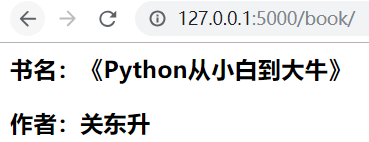
2、Jinja2中使用表达式

from flask import Flask, render_template app = Flask(__name__) @app.route('/hello/<name>') def hello(name): s1 = "Long long ago, there's a girl named betty! She was 5 years old." s2 = " " + s1 + " " s3 = "<p>" + s1 + "</p>" return render_template('hello.html', name=name, message=(s1, s2, s3)) if __name__ == '__main__': app.run(debug=True)

<html> <body> <h3>1+1 = {{ 1+1 }}</h3> <h3>name变量:{{ name }}</h3> <h3>name首字母大写:{{ name|capitalize }}</h3> <h3>name小写:{{ name|lower }}</h3> <h3>name大写:{{ name|upper }}</h3> <h3>所有单词首字母大写:{{ message[0]|title }}</h3> <h3>去除前后空格:{{ message[1]|trim }}</h3> <h3>去除html标签:{{ message[2]|striptags }}</h3> <h3>字符串不转义:{{ message[2]|safe }}</h3> </body> </html>
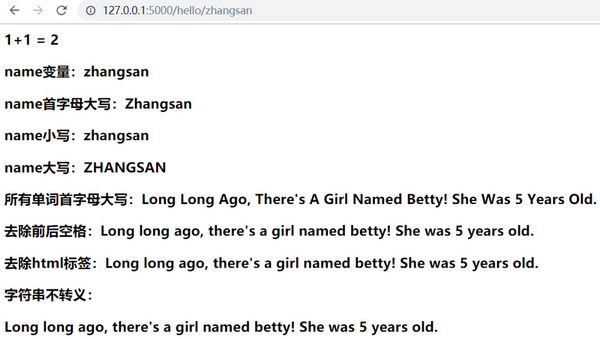
3、Jinjia2模板中语句

from flask import Flask, render_template app = Flask(__name__) @app.route('/book/<float:price>') def show_book_price1(price): info = ''' 书名:《Python从小白到大牛》 作者:关东升 ''' return render_template('book_info.html', price=price, info=info) @app.route('/book/<int:price>') def show_book_price2(price): info = ''' 书名:《Python从小白到大牛》 作者:关东升 ''' return render_template('book_info.html', price=price, info=info) @app.route('/book/') def show_book_info(): book1 = {"bookname": "Python从小白到大牛", "author": "关东升"} book2 = {"bookname": "Java从小白到大牛", "author": "关东升"} book3 = {"bookname": "Kotlin从小白到大牛", "author": "关东升"} list = [] list.append(book1) list.append(book2) list.append(book3) return render_template('books.html', book_list=list) if __name__ == '__main__': app.run(debug=True)

<!DOCTYPE html> <html> <head> <title>图书信息</title> </head> <body> {% for book in book_list %} <h3>书名:《{{ book.bookname }}》</h3> <h3>作者:{{ book.author }}</h3> <hr> {% endfor %} </body> </html>

<!DOCTYPE html> <html> <head> <title>图书信息</title> </head> <body> <h3>{{ info }}</h3> {% if price <= 50.0 %} <h3>很便宜哦!</h3> {% else %} <h3>好贵哦!</h3> {% endif %} </body> </html>
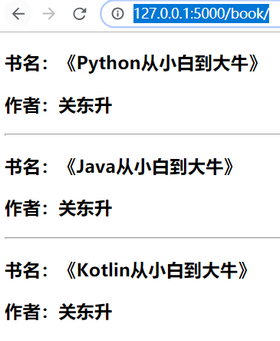
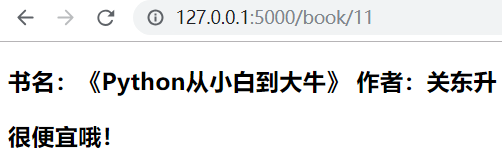
4、模板继承 & 访问静态文件

from flask import Flask, render_template app = Flask(__name__) @app.route('/book/login') def login(): return render_template('login.html') @app.route('/book/reg') def register(): return render_template('registration.html') if __name__ == '__main__': app.run(debug=True)

#footer,#header { text-align: center; } td.label { text-align: right; }

book_img1.jpg
book_img2.jpg

<!doctype html> <html> <head> <meta charset="utf-8"> <title>图书管理系统-{% block title %}{% endblock %}</title> <link rel="stylesheet" type="text/css" href="{{ url_for('static', filename = 'css/book.css') }}"> </head> <body> <!-- 页面头部信息 --> <div id="header"> <img src="{{ url_for('static', filename = 'images/book_img2.jpg') }}" width="20px" height="20px"> {% block header %}{% endblock %} <hr/> </div> <!-- 页面内容信息 --> <div id="content"> {% block body %} {% endblock %} </div> <!-- 页面底部信息 --> <div id="footer"> <hr/> Copyright © 智捷课堂 2008-2018. All Rights Reserved </div> </body> </html>

{% extends "base.html" %} {% block title %}用户登录{% endblock %} {% block header %}用户登录{% endblock %} {% block body %} <table width="40%" border="0"> <tbody> <tr> <td>用户ID:</td> <td><input type="text"/></td> </tr> <tr> <td>密码:</td> <td><input type="password"/></td> </tr> <tr align="center"> <td colspan="2"> <input type="submit" value="确定"> <input type="reset" value="取消"> </td> </tr> </tbody> </table> {% endblock %}

{% extends "base.html" %} {% block title %}用户注册{% endblock %} {% block header %}用户注册{% endblock %} {% block body %} <table width="40%" border="0"> <tbody> <tr> <td class="label">用户名:</td> <td><input type="text"/></td> </tr> <tr> <td class="label">密码:</td> <td><input type="password"/></td> </tr> <tr> <td class="label">再次输入密码:</td> <td><input type="password"/></td> </tr> <tr> <td class="label">邮箱:</td> <td><input type="text"/></td> </tr> <tr align="center"> <td colspan="2"> <input type="submit"> <input type="reset"> </td> </tr> </tbody> </table> {% endblock %}
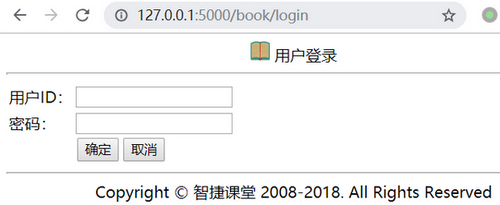
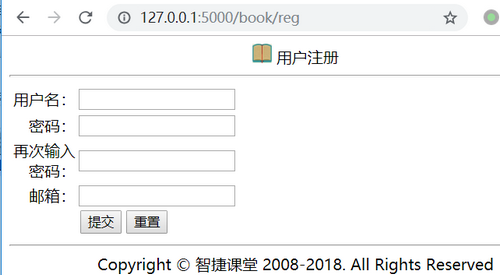
1.6 cookie和session操作
1、设置和获取cookie
set_cookie('userid', 'tony', expires=timeoutdate) # 设置cookie http://127.0.0.1:5000/setcookie
request.cookies.get('userid') # 获取cookie http://127.0.0.1:5000/getcookie

from flask import Flask, make_response, request from datetime import datetime, timedelta app = Flask(__name__) @app.route('/setcookie') def set_cookie(): response = make_response('<h1>设置Cookie') timeoutdate = datetime.today() + timedelta(days=10) # response.set_cookie('userid', 'tony') response.set_cookie('userid', 'tony', expires=timeoutdate) return response @app.route('/getcookie') def get_cookie(): name = request.cookies.get('userid') s = '<h1>Cookie中userid:{0}</h1>'.format(name) return s if __name__ == '__main__': app.run(debug=True)
2、使用session登录注销

from flask import Flask, render_template, request, session app = Flask(__name__) app.secret_key = '任何不容易被猜到的字符串' @app.route('/') def index(): return render_template('login.html') @app.route('/login', methods=['GET', 'POST']) def login(): if request.method == 'POST': session['userid'] = request.form['userid'] return render_template('result.html') @app.route('/logout') def logout(): session.pop('userid', None) return render_template('result.html') if __name__ == '__main__': app.run(debug=True)

#footer,#header { text-align: center; } td.label { text-align: right; }

book_img1.jpg
book_img2.jpg

<!doctype html> <html> <head> <meta charset="utf-8"> <title>图书管理系统-{% block title %}{% endblock %}</title> <link rel="stylesheet" type="text/css" href="{{ url_for('static', filename = 'css/book.css') }}"> </head> <body> <!-- 页面头部信息 --> <div id="header"> <img src="{{ url_for('static', filename = 'images/book_img2.jpg') }}" width="20px" height="20px"> {% block header %}{% endblock %} <hr/> </div> <!-- 页面内容信息 --> <div id="content"> {% block body %} {% endblock %} </div> <!-- 页面底部信息 --> <div id="footer"> <hr/> Copyright © 智捷课堂 2008-2018. All Rights Reserved </div> </body> </html>

{% extends "base.html" %} {% block title %}用户登录{% endblock %} {% block header %}用户登录{% endblock %} {% block body %} <form action = "/login" method = "POST"> <table width="40%" border="0"> <tbody> <tr> <td>用户ID:</td> <td><input name="userid" type="text"/></td> </tr> <tr> <td>密码:</td> <td><input name="userpwd" type="password"/></td> </tr> <tr align="center"> <td colspan="2"> <input type="submit" value="确定"> <input type="reset" value="取消"> </td> </tr> </tbody> </table> </form> {% endblock %}

<!DOCTYPE html> <html> <head> <meta charset="UTF-8"> <title>运行结果</title> </head> <body> <h3>存储在Session中的userid数据:{{ session['userid'] }}</h3> <h3><a href="/logout">Logout</a></h3> </body> </html>
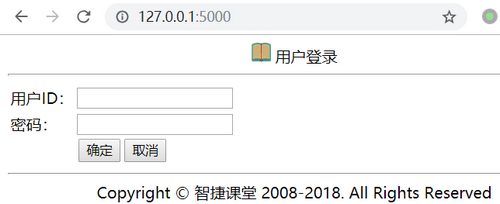

1.7 图片上传预览

from flask import Flask, render_template, request, redirect, url_for, send_from_directory from werkzeug.utils import secure_filename import os app = Flask(__name__) app.config['UPLOAD_FOLDER'] = 'C:/desktop_Important_Document/flask/code/code' # app.config['MAX_CONTENT_LENGTH'] = 1 * 1024 * 1024 # 小于1M @app.route('/') def index(): return render_template('upload.html') @app.route('/upload', methods=['GET', 'POST']) def upload(): if request.method == 'POST': f = request.files['myfile'] filename = secure_filename(f.filename) f.save(os.path.join(app.config['UPLOAD_FOLDER'], filename)) return redirect(url_for('uploaded_file', filename=filename)) @app.route('/uploaded/<filename>') def uploaded_file(filename): return send_from_directory(app.config['UPLOAD_FOLDER'], filename) if __name__ == '__main__': app.run(debug=True)

<!DOCTYPE html> <html> <head> <meta charset="utf-8"> <title>上传文件</title> </head> <body> <form action="/upload" method="POST" enctype="multipart/form-data"> <input type="file" name="myfile"><br><br> <input type="submit" name="开始上传"> </form> </body> </html>

<!DOCTYPE html> <html> <head> <meta charset="UTF-8"> <title>上传结果</title> </head> <body> <h1>{{ result }}</h1> <img src="{{ path }}"> </body> </html>
1.8 Flask-Migrate 数据库操作
1、安装相关包
pip install Flask==0.11.1
pip install Flask-Script==2.0.5
pip install Flask-Migrate==1.8.0
pip install Flask-SQLAlchemy==2.2

#! /usr/bin/env python # -*- coding: utf-8 -*- from flask import Flask from flask_sqlalchemy import SQLAlchemy from flask_script import Manager from flask_migrate import Migrate, MigrateCommand app = Flask(__name__) app.config['SQLALCHEMY_DATABASE_URI'] = 'sqlite:///app.db' db = SQLAlchemy(app) migrate = Migrate(app, db) manager = Manager(app) manager.add_command('db', MigrateCommand) class User(db.Model): id = db.Column(db.Integer, primary_key=True) name = db.Column(db.String(128)) if __name__ == '__main__': manager.run()
2、相关文件

#! /usr/bin/env python # -*- coding: utf-8 -*- from flask_script import Manager from flask_migrate import Migrate, MigrateCommand from platform import app from exts import db from models import User, Question, Answer manager = Manager(app) # 使用Migrate绑定app和db migrate = Migrate(app, db) # 添加迁移脚本的命令到manager中 manager.add_command('db', MigrateCommand) if __name__ == '__main__': manager.run()

#! /usr/bin/env python # -*- coding: utf-8 -*- import os DEBUG = True SECRET_KEY = os.urandom(24) SQLALCHEMY_DATABASE_URI = 'mysql://root:1@localhost/testdb' SQLALCHEMY_TRACK_MODIFICATIONS = True

#! /usr/bin/env python # -*- coding: utf-8 -*- from flask_sqlalchemy import SQLAlchemy db = SQLAlchemy()

#! /usr/bin/env python # -*- coding: utf-8 -*- from exts import db from datetime import datetime class User(db.Model): __tablename__ = 'user' id = db.Column(db.Integer, primary_key=True, autoincrement=True) telephone1 = db.Column(db.String(11), nullable=False) username = db.Column(db.String(50), nullable=False) password = db.Column(db.String(100), nullable=False) class Question(db.Model): __tablename__ = 'question' id = db.Column(db.Integer, primary_key=True, autoincrement=True) title = db.Column(db.String(100), nullable=False) content = db.Column(db.Text, nullable=False) # now()获取的是服务器第一次运行的时间 # now就是每次创建一个模型的时候,都获取当前的时间 create_time = db.Column(db.DateTime, default=datetime.now) author_id = db.Column(db.Integer, db.ForeignKey('user.id')) author = db.relationship('User', backref=db.backref('questions')) class Answer(db.Model): __tablename__ = 'answer' id = db.Column(db.Integer, primary_key=True, autoincrement=True) content = db.Column(db.Text, nullable=False) create_time = db.Column(db.DateTime, default=datetime.now) question_id = db.Column(db.Integer, db.ForeignKey('question.id')) author_id = db.Column(db.Integer, db.ForeignKey('user.id')) question = db.relationship('Question', backref=db.backref('answers', order_by=id.desc())) author = db.relationship('User', backref=db.backref('answers'))

#! /usr/bin/env python # -*- coding: utf-8 -*- from flask import Flask, render_template, request, redirect, url_for, session import config from models import User, Question, Answer from exts import db app = Flask(__name__) app.config.from_object(config) db.init_app(app) @app.route('/') def index(): # context = { # 'questions': Question.query.order_by('-create_time').all() # } return 'test '
3、创建数据库表命令
python manage.py db init # 创建迁移的仓库
Python manage.py db migrate # 创建迁移的脚本
python manage.py db upgrade # 更新数据库
python manage.py runserver # 运行项目
11111111111111111111
